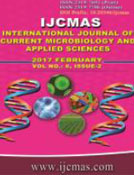


 National Academy of Agricultural Sciences (NAAS)
National Academy of Agricultural Sciences (NAAS)

|
PRINT ISSN : 2319-7692
Online ISSN : 2319-7706 Issues : 12 per year Publisher : Excellent Publishers Email : editorijcmas@gmail.com / submit@ijcmas.com Editor-in-chief: Dr.M.Prakash Index Copernicus ICV 2018: 95.39 NAAS RATING 2020: 5.38 |
Waxes are esters of long-chain fatty acids with long-chain fatty alcohols found abundant in the environment in various forms. Bacteria degrading these waxes in agricultural residues, soils and insects are gaining increased attention. In India, about 500 million tonnes of crop residues are generated annually and these crop residues are rich in cellulose, hemicellulose, lignin, pectin, cutin, waxes, fats and oils. Accumulation of waxy rich crop residues in the environment decreases the rate of decomposition and increase the hydrophobicity of soils. In turn, biodegradation of these abundant plant polysaccharides and neutral lipids of waxes and fats by suitable microorganisms could increase availability of nutrients and growth promoting substances in soil. Various wax degrading eubacteria genera, Pseudomonas, Alcaligenes, Micrococcus, Nocardia, Corynebacteria, Arthrobacter, Bacillus, Rhodococcus and Proteus capable of decomposing waxy rich residues are prevalent in the environment. Water repellency due to waxy coatings around soil particles could also be overcome by inoculation of selected biosurfactant producing, wax degrading bacteria in water repellent soils. Potential of wax degrading bacteria for control of wax coated homopteran insects like Aleyrodoidea (whiteflies); Aphidoidea (aphids) and Coccoidea (scale insects and mealybugs) is also being investigated from viewpoint of sustainable insect pest management.
 |
 |
 |
 |
 |